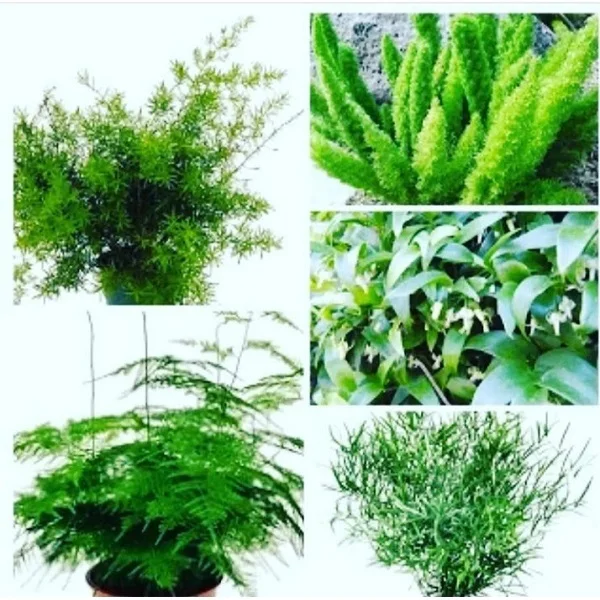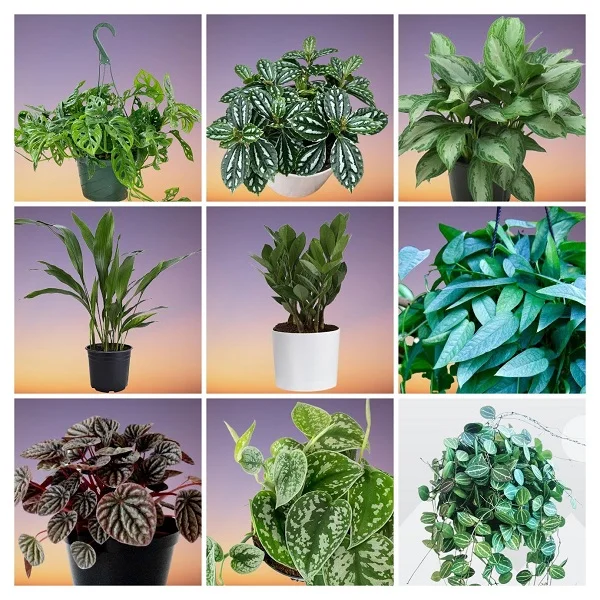Cyrtomium falcatum (Holly Fern) Indoor Care, Propagation and Common Problems
Some links in this post may be affiliate links
Cyrtomium falcatum (Holly Fern) thrives in medium to bright indirect light, average warmth and humidity and consistently moist, rich, well-drained soil coupled with monthly feeding in the growing season.
Holly Fern also called Japanese Holly Fern is among the popular fern plants and bears toothed, sharp-tipped, holly-like leaves and tolerates lower light and saline conditions better than most ferns.
Each leaflet may be flat, wavy or slightly toothed along the edges and it bears a large light brown rhizome. The leaves are about 1.6 feet long and are made up of 6-10 pairs of shiny bright green leaflets. It is easily propagated by spores or by division of the undeground rhizome.
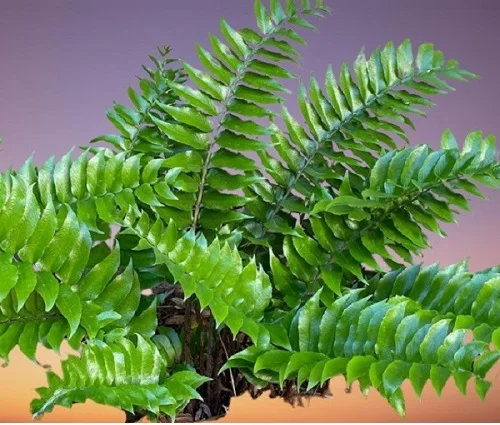
Botanical name: Cyrtomium falcatum
Family: Dryopteridaceae
Common names: Holly Fern, Japanese Holly Fern
Origin
Cyrtomium falcatum is native to eastern Asia where it grows from crevices in coastal cliffs, stream banks, rocky slopes and other moist areas.
Size
Japanese Holly Fern is a large fern which grows to a height of 2 feet with a spread of about 3 feet which makes it one of the best plants for an office desk without sunlight and other low-light limited spaces.
Is Cyrtomium falcatum toxic?
No. Cyrtomium falcatum is non-toxic to humans and pets as indicated by ASPCA. It is not poisonous to cats, dogs and other pets. It is safe to grow in a home with kids and pets.
Where to Buy
Holly Ferns are a great addition to any plant collection, you may acquire these plants online from Etsy (Link to Etsy).
How to Care for Cyrtomium falcatum Indoors
To care for Cyrtomium falcatum indoors, provide medium to bright indirect light (filtered light), warmth of 15-240C, humidity of 50-55% and consistently moist, fertile, well-drained soil coupled with monthly feeding in spring and summer.
Holly Fern requires timely repotting as overcrowding can result in wilting and eventual death of the fern. Pruning is necessary to keep it neat as well as reduce pests and diseases. Keep reading for more on these growing conditions and how to achieve them.
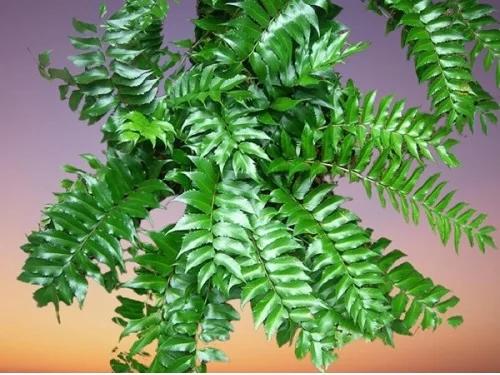
Watering
How often should I water a Holly Fern?
For optimum growth of Holly Fern, keep the soil consistently moist in spring and summer. Water the soil when the top 1-2 inches of soil feels dry to the touch. Avoid overwatering to prevent rotting, yellowing and leaf drop.
Reduce watering in fall and winter as growth is minimal at this time. Never allow the soil to dry out completely to prevent wilting, yellowing and leaf loss.
Use room temperature water to prevent cold shock which can result in stunted growth and leaf fall. Only water with chlorine-free water like rainwater to prevent staining and browning of leaves.
Make sure that the soil is well-draining and the pot has a drainage hole to prevent the soil from getting soggy as it can lead to rotting and death of the plant.
Light Requirements
Cyrtomium falcatum grows best in medium to bright indirect light. Keep it away from direct sunlight as it may scorch the fronds; brown leaf marks.
Where natural light is not adequate, you may use full spectrum grow lights to supplement it to prevent slowed growth, yellowing and leaf drop.
Turn the pot regularly to ensure that the fern receives light on all sides for even growth.
Temperature & Humidity
Holly Fern flourishes in a warmth of 15-240C; a room temperature that are comfortable for you are ideal for this fern.
Keep the fern away from sources of drafts like AC units, windy doors, hot air vents, stoves among others to prevent stunted growth and leaf loss.
Cyrtomium falcatum blossoms in a humidity of 50-55%. If the air is too dry especially where the room temperatures are high, set the pot on a wet pebble tray to increase humidity. Maintain a good air circulation to discourage pests and diseases.
Fertilizer
Feed Holly Fern with a balanced water-soluble fertilizer once a month in spring and summer for lush growth. Withhold feeding in fall and winter as growth is reduced at this time.
Regularly leach out excess salts by running a stream of water through the soil until it comes out through the drainage hole.
Potting Soil
The best soil for Holly Fern should be rich in organic matter and free-draining to prevent it from getting soggy while providing the required nutrients. A blend of 2 parts organic potting mix and 1 part perlite (for drainage) is recommended for this fern.
Repotting
Repot Holly Fern every 2-3 years at the beginning of the growing season (spring to early summer) to provide adequate room for the growth of the rhizome.
One sign of an overcrowded Holly Fern is wilting leaves. Failure to repot an overcrowded fern can result in death of the plant.
Repot into a pot that is 1 size larger that has drainage hole to prevent the soil from getting soggy as it can lead to rotting.
You can also be divide a large plant into several sections during repotting and pot the sections individually. Take a look at these pots with a saucer on Amazon.
Pruning
Remove dead and damaged fronds from Holly Fern to keep it neat and discourage pest and disease infestations. As it ages, the older fronds turn brown. Cut them off at the base to maintain the plant neat and tidy.
Cyrtomium falcatum Propagation
Cyrtomium falcatum is propagated by plant division or by germinating the spores. It is best propagated at the beginning of the growing season (spring to early summer) when it is in active growth for faster establishment.
1. Propagating Holly Fern by plant division
- Carefully remove the fern from its pot and divide the rhizome into several sections. Ensure each section has adequate roots.
- Fill small pots one thirdway with a well-draining soil. Use pots with drainage holes to prevent rotting.
- Position a section in the center pot and continue to cover the roots with the soil. Make sure that you do not bury the rhizomes too deep but maintain the same soil level they were at in the previous pot.
- Place the pots in a warm, well-lit place away from direct sunlight to prevent scorching.
- Maintain the soil moist through out until the new ferns are well established after which you can begin routine care.
2. Propagating Holly Ferns from spores
- Spores are brown dots on the underside of the fronds. When they ripen, the cases open and tiny dust-like spores fall out.
- Cut the frond and place it on a piece of paper with the spores side down.
- Allow time for the spores to fall out of the cases onto the piece of paper.
- The spores can also be obtained by shaking the frond occasionally.
- Thinly spread the spores on moist soil and cover the set up with clear polythene to maintain humidity and warmth.
- Place the set up in a brightly lit area. The spores should sprout in 1-2 months.
- Allow the new ferns to be well established before transplanting after which you can begin routine care.
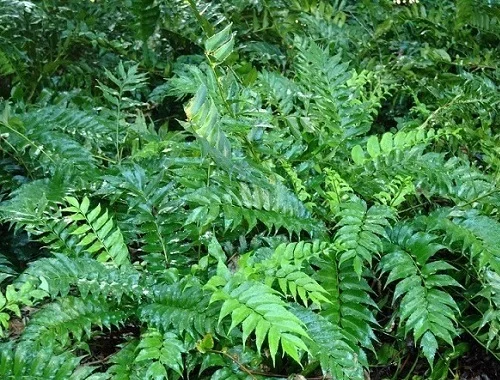
Holly Fern Problems & Solutions
What are the common problems with Holly Ferns?
Holly Fern common problems are browning, yellowing, leaf drop, wilting leaves, brown leaf tips, pests among others. Keep reading for more on these problems and how to fix them.
Brown leaves
The main causes of brown leaves on your Holly Ferns are underwatering, soggy soil extreme temperatures, and fertilizer burn.
How to fix it
Underwatering: Do not water on a schedule. Water when the top 1-2 inches of soil feels dry to touch.
Soggy soil: Use a pot with a drainage hole and fast-draining soil.
Extreme temperatures: Keep the plant away from sources of drafts like AC units, windy doors, heat sources, hot air vents among others.
Salts buildup: Avoid too much fertilizer and do not feed in fall and winter. Flush out excess chemicals from the soil.
Yellow leaves
Some of the causes of yellow leaves on your Holly Ferns are too little light, soggy soil, inconsistent watering, drafts, nutrients deficiency or aging.
How to fix it
Too little light: Position the plant in bright indirect light or use a grow light if you do not have adequate light in your home.
Soggy soil: Use fast-draining soil and a pot with a drainage hole.
Inconsistent watering: Water when the top 1-2 inches of soil feel dry to the touch but do not allow the soil to dry out completely.
Drafts: Keep the plant away from sources of drafts like hot air vents, AC units, hot surfaces, windy doors among others.
Nutrients deficiency: Feed the plant every 4 weeks in spring and summer with a balanced, water-soluble fertilizer.
Aging: This is a natural process. As the lower leaves mature, they turn yellow, brown and eventually die.
Excessive leaflet drop
Leaflets drop on Holly Fern is caused by inconsistent watering, soggy soil, dry air or temperature stress.
How to fix it
Inconsistent watering: Water when the top 1-2 inches of soil feel dry but do not leave it to dry out completely.
Soggy soil: Use a well-draining soil and a pot that has a drainage hole.
Dry air: Set the pot on a wet pebble tray, use a cool mist humidifier or group the plants together.
Temperature stress: Keep the fern away from drafts emanating from AC units, hot surfaces, stoves, windy doors among others.
Wilting leaves
Wilting leaves on Holly Ferns is an indication of underwatering, drafts or being pot-bound.
How to fix it
Underwatering: Water when the top 1-2 inches of soil dry out but do not allow the soil to dry out completely.
Drafts: Keep the plant away from sources of drafts like hot air vents, AC units, heat sources, stoves among others.
Being pot-bound: Repot the Fern into a larger pot or divide it up for more ferns.
Brown leaf tips
Brown leaf tips on Holly Ferns are caused by dry air, salts buildup and underwatering.
How to fix it
Dry air: To raise humidity, set the pot on a wet pebble tray, use a cool mist humidifier or group the plants together.
Salts buildup: Leach out accumulated salts by running a stream of water through the soil until it drains through the drainage hole.
Underwatering: Water when the top 1-2 inches of soil dry out but do not let the soil dry out completely.
Brown dots or lines on the underside of fronds
These are spores which can be used for propagation of new Holly Ferns. They indicate that the frond is mature and healthy. In their natural environment, these spores drop to the soil and grow into new Ferns.
Pests
Common pests on Holly Ferns are scales and mealy bugs which are most prevalent in dry, stuffy conditions.
How to fix it
- Isolate the affected fern to prevent spread to the other plants.
- Treat the fern with a horticultural oil as per the manufacturer's recommendations.
- Regularly check underneath and between the leaves for these pests and carry out timely control measures.
- Maintain the fern well pruned and elevate humidity to minimize the pest infestations.
You liked it? Share on social media.
Related Content
Amazon Associates Disclosure
Homeplantsguide.com is a participant in the Amazon Services LLC Associates Program, an affiliate advertising program designed to provide a means for sites to earn advertising fees by advertising and linking to amazon.com.



